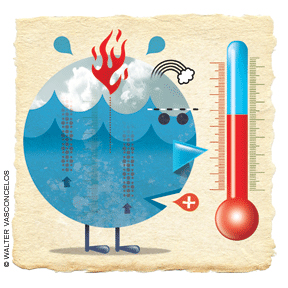
Andrew Kemp Gr’09 set out to develop a doctoral thesis. He ended up producing a scientific breakthrough.
Working with Benjamin Horton, an associate professor of earth and environmental science, and a team of other researchers, Kemp has demonstrated that the sea level along the east coast of North America has risen far faster over the last century than at any time in the previous 2,000 years. The group also established once and for all that there is a near-perfect correlation between rising temperature and rising sea level.
The study represents the first continuous record of sea-level changes over the past 2,000 years. Kemp and Horton pieced together this timeline by digging up and dating microfossils in the salt marshes of North Carolina.
The paper, which was published in the Proceedings of the National Academy of Sciences, identifies four main stages of sea-level change over the past two millennia. Between 200 BCE and 900 CE, the sea level was stable. Between the 10th and 14th centuries, also known as the Medieval Warm Period, the sea level rose. Then it stabilized, and even dropped slightly during the period known as the Little Ice Age, which lasted until the middle of the 19th century. Since the Industrial Revolution, both temperature and sea level have been rising.
During this fourth and final stage, Horton says, sea level is rising “far faster than anything over the last 2,000 years.” Whereas most sea-level changes took place gradually over hundreds of years, a very rapid rise in sea level occurred between 1860 and 1890, Horton says—right around the time of industrialization.
If temperatures continue to rise in the 21st century, says Horton, “It doesn’t take a rocket scientist to figure out that sea levels are going to rise.”
The study involved a lot of tricky detective work, and “it took Andy five years of his life,” Horton says. (Kemp, who is now a postdoctoral fellow at the Yale Climate and Energy Institute, was doing field research in a remote section of Alaska as this story was going to press.)
The salt marshes of North Carolina are home to several species of microscopic organisms called foraminifera. Different types of foraminifera thrive in different conditions. Some like to live in freshwater areas away from where the ocean tides hit the marsh, while others prefer brinier environments closer to the tidal zone.
Kemp and Horton extracted foraminifera fossils and radiometrically dated them to figure out where the tide was situated during different time periods. For further accuracy, they incorporated historical evidence—core samples from the time of European colonization, for example, contain traces of pollen associated with the settlers’ agricultural activities.
Kemp and Horton had proved the efficacy of this technique last November, when they published a sea-level timeline dating back 500 years in the journal Geology [“Gazetteer,” Jan|Feb 2010]. That paper showed that the geological record reconstructed from foraminifera matched instrumental records kept by scientists over the past century. “The fact that our geological data matched the instrumental [data] over the 20th century gave us great confidence in going back further in time,” Horton says, adding that Foraminifera “have been used for over 50 years as sea-level indicators.”
Kemp and Horton continue to collaborate to further their understanding of sea-level rise. They are currently working in New Jersey to define exactly when the modern rate of sea-level rise began, and to determine what caused it.
The implications of their 2,000-year timeline are game-changing, according to Horton. The finding will allow climate modelers to do a better job at predicting future sea-level changes. In turn, more accurate models will help inform strategies to cope with rising tide lines.
“If you’re going to tell people that sea level is going to rise, that people need to evacuate, that [existing] highways and military bases will be unusable,” Horton says, you need sound data to back you up.
—Maanvi Singh C’13




